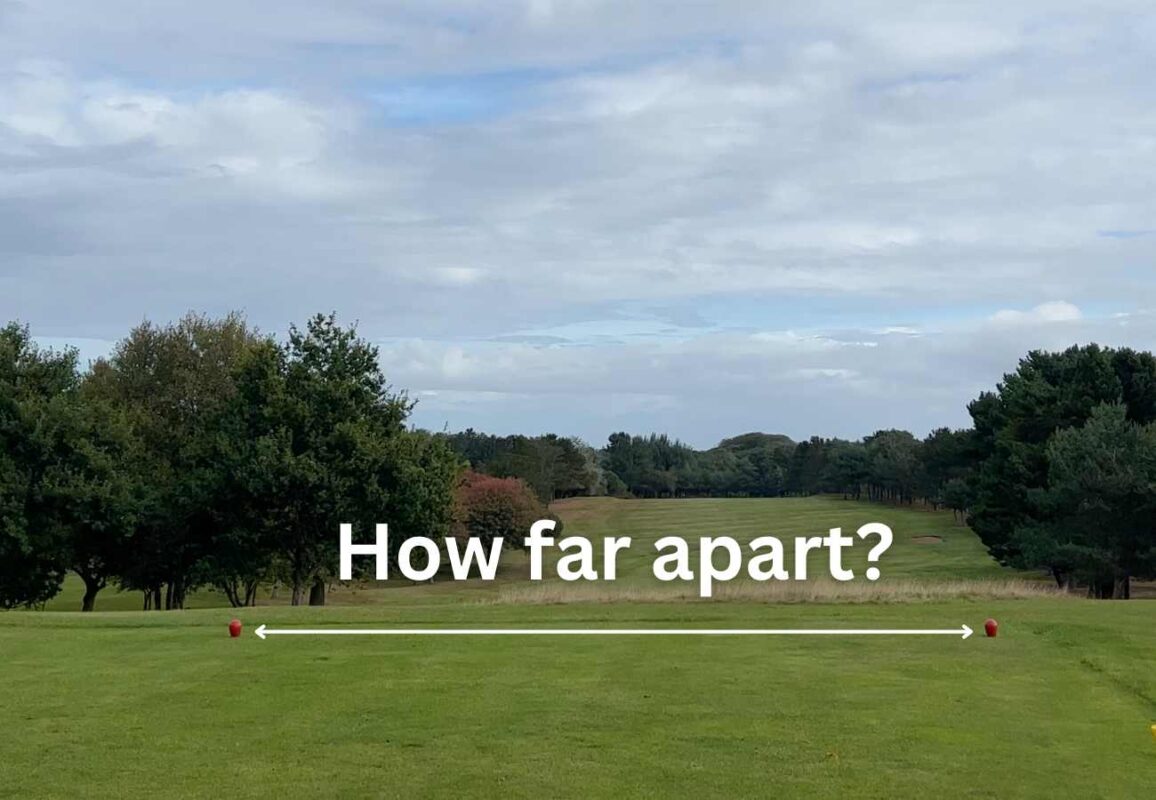
Mid-Handicap golfer who loves to share his rounds and experiences playing courses all around the UK in a hope that it will help others find those hidden gem golf courses.
I seek out golf courses that don’t get the credit they deserve and are often overlooked for the bigger more well known ones.
Tee markers are small objects or signs that indicate the starting point for each hole on a golf course. They serve as a guide for players to know where to tee off from and help maintain consistency throughout the course.
In this post, we will dive into the details and provide some insights on the ideal distance between tee markers for different levels of play. So let’s get started!
Tee markers should generally be placed approximately 15 to 18 feet apart, equivalent to about five to six paces, to provide ample space for players to tee up their ball comfortably.

What Do Tee Markers Serve As
Tee markers serve as the designated starting point from which players must hit their first stroke on each hole in a round of golf.
In the game of golf, tee markers are an integral part of the play.
They are typically small, often brightly coloured, and are placed at the beginning of each hole to indicate where players should place their ball for the initial shot, also known as the tee shot.
The position of these markers can vary depending on the difficulty of the hole and the course’s overall design.
Different colours of tee markers usually represent different levels of play.
For example, red markers often denote forward tees for high-handicap or novice golfers, while black or gold markers indicate championship tees for low-handicap or professional golfers. White and blue markers typically fall somewhere in between.
Regardless of colour or placement, the primary function of tee markers is to provide a fair and consistent starting point for all players on each hole, maintaining the integrity and challenge of the game.

How Far Apart Should Tee Markers Be
The placement of tee markers can vary, but as a general guideline, they should be positioned five to six paces apart, equivalent to approximately 15 to 18 feet.
The positioning of tee markers on a golf course plays an essential role in the game. These markers define the area from which players must hit their first stroke on each hole.
While there are no strict regulations regarding the exact distance between tee markers, a common practice is to set them about five to six paces apart.
This distance, translating roughly to 15 to 18 feet, allows ample space for players to tee up their ball comfortably.
It’s important to note that the precise distance can vary based on the design and layout of the particular golf course, as well as the specific hole being played.
The objective is to provide a fair and consistent starting point for all players, while also maintaining the integrity and challenge of the game.
Therefore, while the five to six-paces guideline is widely used, it’s ultimately up to the discretion of the golf course management to determine the best placement of tee markers on their course.
Types of Tee Markers
In golf, there are several types of tee markers, often distinguished by colour, which represent different levels of play including red, white, blue, and black or gold markers.
Red Tee Markers
Red tee markers usually denote the forward tees on a golf course. They are typically used by high-handicap or novice golfers, as they shorten the overall length of the course, making the game less challenging. The shorter distance allows beginners to learn the game without being overwhelmed by the full length of the course.
White Tee Markers
White tee markers are generally used by mid-level or average golfers. These markers offer a moderate challenge, providing an intermediate level of difficulty between the red and blue tees. Players who have some experience and skills but are not yet ready for the more challenging blue or black tees often start from the white markers.
Blue Tee Markers
Blue tee markers are designed for low-handicap or experienced golfers. They are placed further back than the red and white markers, increasing the overall length and difficulty of the course. Golfers playing from the blue tees require a good skill level, as they will face longer distances to the hole.
Black or Gold Tee Markers
Black or gold tee markers indicate the championship tees, the farthest set back on the course. These tees are designed for professional or very low-handicap golfers, offering the highest level of difficulty. Playing from these tees requires advanced skills and strategies, as it presents the maximum challenge that the course can offer.
How Many Sets of Tee Markers Should There Be On a Golf Course?
A golf course typically has between 3 to 5 sets of tee markers, catering to players of varying skill levels.
In the sport of golf, it’s important to cater to a wide range of player abilities. This is why golf courses usually feature anywhere from three to five sets of tee markers.
These different sets provide various starting points on each hole, effectively adjusting the length and difficulty of the course.
The colour system of the tee markers often indicates the level of difficulty, with red tees being the easiest, followed by white, and then blue. Black or gold tees are usually the most challenging. Some larger courses may even have six or more sets of tee boxes, offering an even broader range of options for players.
These various sets of tees not only cater to the differing skills of golfers but also contribute to the overall enjoyment and challenge of the game. By selecting the appropriate tee, golfers can play a course that matches their skill level, making the game both fair and enjoyable.
FAQs
Q: What is tee placement?
A: Tee placement refers to the specific position of the tee markers on the teeing ground. It is important to have proper tee placement to create a fair and challenging course for golfers.
Q: How do tee markers qualify the distance on a hole?
A: Tee markers indicate the starting point and the distance a golfer needs to cover on a hole. They help golfers determine the appropriate club to use for their shots.
Q: How should tee markers be positioned on a hole?
A: Tee markers should be placed at a suitable distance from the front of the teeing area, allowing golfers to tee off comfortably and safely.
Q: What should a golfer do when teeing off?
A: A golfer should place the ball on top of a tee, which is set within the teeing area. They should then make a swing to hit the ball towards the fairway.
Q: Who is responsible for determining the placement of tee markers on a golf course?
A: The superintendent or overall course management is responsible for determining the proper tee marker placement based on the course design and setup.
Q: Can tee markers be rotated on a golf course?
A: Yes, tee markers can be rotated to change the tee placement and create variation in the course setup. This allows golfers to experience different challenges.
Q: How should golfers approach teeing off when faced with overhang or divots caused by previous golfers?
A: Golfers should stand outside the overhang or divot area, ensuring they do not place their feet inside it. They should then tee off as normal, aiming for the fairway.
Conclusion and final thoughts
The placement of tee markers on a golf course is an important factor in determining the difficulty and enjoyment of the game for players.
While there are no hard and fast rules for how far apart tee markers should be placed, it is important to consider factors such as course length, player skill level, and course design when making this decision.
Affiliate Disclaimer – As an affiliate, we may earn a commission from qualifying purchases. We get commissions for purchases made through links on this website from Amazon and other third parties.









Leave a Reply